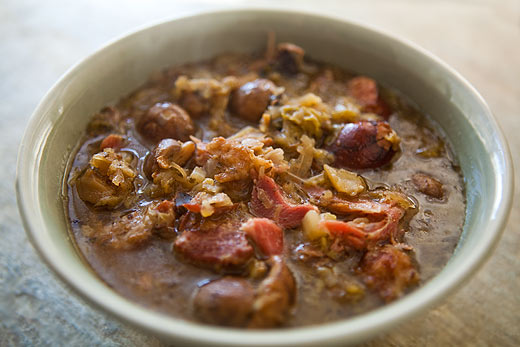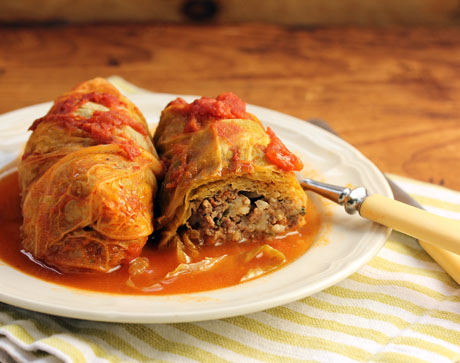… is one of the reason I wanted to move here.
Day: March 16, 2014
Sunny, lazy Sunday afternoon
Sitting on the beach right now, watching Bean making sandcastles, hoping he doesn’t get eaten by a swan, hearing other exasperated parents saying things like don’t throw rocks at the swans, leave that boy’s castle alone, you’re getting on my nerves… Not just me :-)
I keep saying things like she didn’t mean to, stop throwing sand, there’s enough beach for everybody…
Gorgeous weather though.
Edit
More pictures put online here: https://www.flubu.com/blog/pictures/morges_mar_2014/
[Recipe] Bigos – Polish hunter’s stew
INGREDIENTS
50g dried porcini or other wild mushrooms
2 Tbsp bacon fat or vegetable oil
1kg pork shoulder, cubed
1 large onion, chopped
1 head cabbage (regular, not savoy or red), chopped
750g pounds mixed fresh mushrooms
500g kielbasa or other smoked sausage
1 smoked ham hock
500g fresh Polish sausage (optional)
1 medium tin chopped tomatoes
1 bottle of pilsner or lager beer
1 Tbsp juniper berries (optional)
1 Tbsp black peppercorns
1 Tbsp caraway seeds
2 Tbsp dried marjoram
Salt
2 Tbsp tomato paste (optional)
1-2 Tbsp mustard or horseradish (optional)
METHOD
1 Pour hot tap water over the dried mushrooms and submerge them for 20-40 minutes, or until soft. Grind or crush the juniper berries and black peppercorns roughly; you don’t want a powder. Cut the pork shoulder into large chunks, about 2 inches. Cut the sausages into similar-sized chunks. Clean off any dirt from the mushrooms and cut them into large pieces; leave small ones whole.
2 Heat the bacon fat or vegetable oil in a large lidded pot for a minute or two. Working in batches if necessary, brown the pork shoulder over medium-high heat. Do not crowd the pan. Set the browned meat aside.
3 Put the onion and fresh cabbage into the pot and sauté for a few minutes, stirring often, until the cabbage is soft. Sprinkle a little salt over them. The vegetables will give off plenty of water, and when they do, use a wooden spoon to scrape any browned bits off the bottom of the pot. Add the tomato paste. Once the pot is clean and the cabbage and onions soft, remove from the pot and set aside with the pork shoulder.
4 Add the mushrooms and cook them without any additional oil, stirring often, until they release their water. Once they do, sprinkle a little salt on the mushrooms. When the water is nearly all gone, add back the pork shoulder, the cabbage-and-onion mixture, and then everything else. Add the beer and chopped tomatoes. Stir well to combine.
5 You should not have enough liquid to submerge everything. That’s good: Bigos is a “dry” stew, and besides, the ingredients will give off more liquid as they cook. Bring everything to a simmer, cover the pot and cook gently for at least 2 hours.
6 Bigos is better the longer it cooks, but you can eat it once the ham hock falls apart. Check at 2 hours, and then every 30 minutes after that. When the hock is tender, fish it out and pull off the meat and fat from the bones Discard the bones and the fat, then chop the meat roughly and return to the pot.
Bigos is best served simply, with rye bread and a beer. If you want a little kick, add the mustard or horseradish right before you eat it. Bigos improves with age, too, which is why this recipe makes so much: Your leftovers will be even better than the stew was on the first day.
[recipe] Golabki – Polish stuffed cabbage rolls
Adapted from several recipes found online
Ingredients
1 head Savoy cabbage (3-4 lbs)
1 Tbsp olive oil
1 small onion, minced
1 small carrot, shredded (on a box grater)
1 stalk celery, minced
1-1/4 lb lean ground beef or turkey
2/3 cup cooked long-grain white rice
2 Tbsp tomato paste
2 Tbsp chopped fresh flat-leaf parsley
1 tsp kosher salt
1 tsp fresh black pepper
1/2 cup canned chopped tomato
1L tomato juice
Directions
Cut the core out of the cabbage, and leave it whole. Bring a large pot of water to a boil. Submerge the cabbage, core side up, in the boiling water. Reduce heat to low, and simmer for 10-15 minutes. (Hint: if the cabbage floats to the top, set a small ceramic plate on top to keep the ribs of the cabbage leaves under water.)
While the cabbage is in the pot, heat the oil in a large Dutch oven or deep pan (the one you’ll use for cooking the cabbage rolls — I use a 12-inch straight-sided pot, with a lid). Sauté the onion, carrot and celery until the vegetables are soft, 2-3 minutes. Scrape the mixture into a large mixing bowl and set it aside to cool.
Remove the cabbage from the hot water, and carefully peel off the outer leaves (you’ll need 18 leaves, or fewer if some of the leaves are large enough to be cut in half). Work with one leaf at a time. Dry each leaf with paper towels. Place the leaf cupped side down on the counter. With a very sharp paring knife, slice off the hardest part of the center rib (or, you can cut it out, and overlap the two flaps of the cabbage leaf to fill the gap). Pile up the whole, trimmed leaves; chop the remaining cabbage into 1-inch pieces, and layer them in the bottom of your cooking pan.
Add to the mixing bowl with the sautéed vegetables the ground beef, cooked rice, tomato paste, parsley, salt and pepper. Mix well (with your hands).
Set one of the cabbage leaves on the counter, cupped side facing up. (If you’ve cut the rib away, overlap the two flaps of the leaf.) Make a small log out of 2-3 tablespoons of the meat filling, and set it at the end of the leaf closest to you. If you’ve ever made eggrolls, you know what to do next. Fold up the bottom of the leaf over the mixture. Then fold in both sides, and roll the leaf to cover all of the filling. Place the rolled, filled cabbage leaf in the pot, on top of the chopped cabbage.
Continue with the remaining leaves and remaining meat mixture. Pack the leaves into the pot tightly; you’ll need to make two layers.
Sprinkle the chopped tomato over the cabbage rolls, and pour in the tomato juice to cover. If the juice doesn’t cover, add some beef broth or water so that the rolls are almost covered, but not totally submerged.
Bring the liquid to a boil over high heat. Then, cover the pot and reduce the heat to low. Cook for 45 minutes (check midway through; if the liquid in the pot is boiling, reduce heat to simmer).
Let the cabbage rolls cool for 5-10 minutes before serving, or let cool completely and refrigerate or freeze. Save any extra braising liquid and the chopped cabbage from the base of the pot — it’s the perfect start to a wonderful soup.





